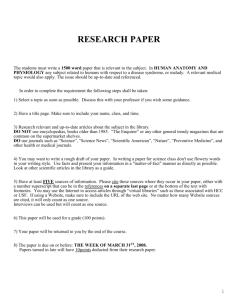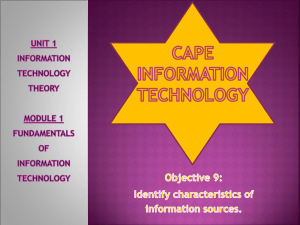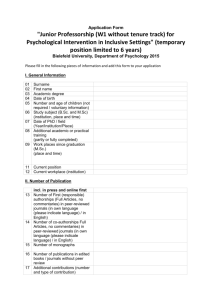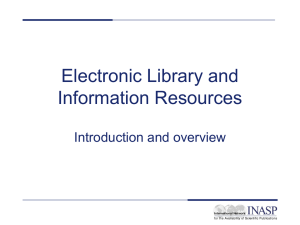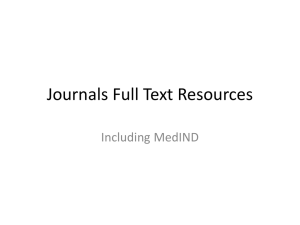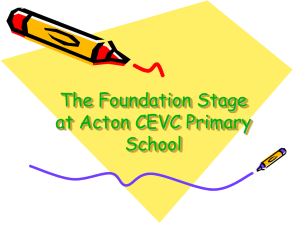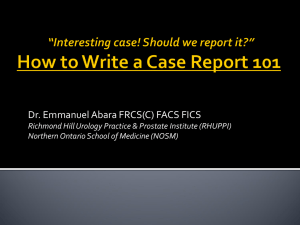Electronic Journals and Electronic Resources Library
advertisement
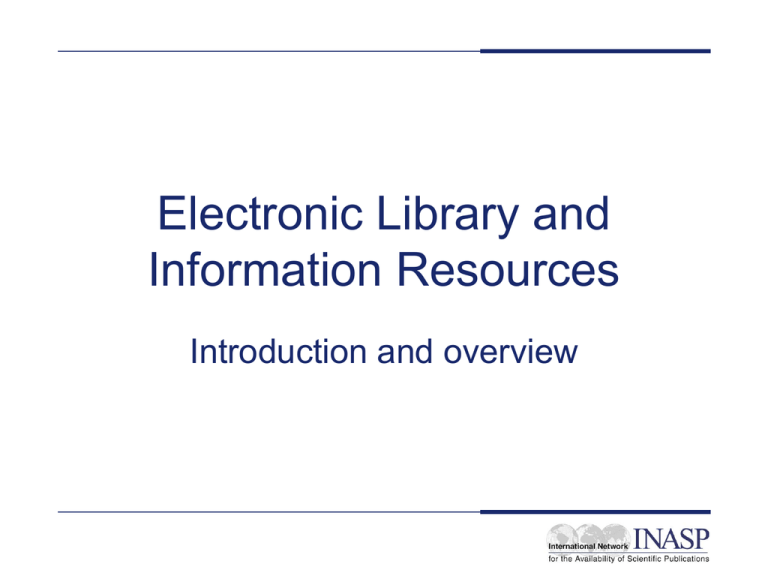
Electronic Library and Information Resources Introduction and overview Objectives To review and define what electronic library and information resources are and consider – their features and functionality – their strengths and weaknesses – why you might want to use them • To consider other electronic resources Electronic library resources • Any library or information resources that can be accessed electronically, e.g. – electronic journals – scholarly databases – electronic books – hybrid digital collections – Internet gateways and search engines • Free or fee-based access Electronic journal formats • Full-text—whole journal available – Electronic version of print – Electronic only • Partial full-text—selected articles only • Table of contents/abstracts only Why use e-journals? • An up-to-date resource • Convenience • Extra features—e.g. search facilities, links to other databases, supplementary information • Access to a wider range of material than might otherwise be available through your local library Types of electronic resource • Academic – – – – Refereed journals Review journals Pre-prints Bulletins • Non-academic – Professional/trade journals – Magazines – Newspapers Academic journals • Example: African Crop Science Journal – www.inasp.org.uk/ajol/journals/acs/about.html • Used to – disseminate research findings – find out about research being carried out by others in your field – identify methodologies that might be relevant to your own work Academic journals • Features – – – – written by researchers and experts aimed at researchers and experts articles always cite sources peer reviewed • Strengths/weaknesses – high-quality, reliable information – may be slow to be published due to lengthy review process – often fee-based access Review journals Example MathSciNet – http://www.ams.org/mathscinet/search Used to give an overview of the current literature in a specific research area or discipline • Features – Give an overview of the current literature in a specific research area or discipline – Titles usually contain ‘Review’, ‘Reviews’, Advances in, ‘Current opinion in’, ‘Progress in’, ‘Trends in’ – Have already done much of the literature searching for you Bulletins • Example: Africa Research Bulletin – http://www.africa-research-bulletin.com/ • Used for: – making announcements to a specific audience – up-to-date information in a very specific area • Features – written by in-house staff, or staff writers – may be issued as required, sometimes intermittently – contain short reports • Strengths/weaknesses – very up-to-date – standard very variable Pre-prints • Example: The Physics Eprint Archive – http://xxx.lanl.gov/ – now includes more than 70% of the current physics literature world-wide • Used to: – circumvent lengthy journals publication process – solicit and provide informal prepublication feedback on new ideas and findings Pre-prints • Features – written by researchers for researchers – accessed online from a pre-print server • Strengths/weaknesses – very up-to-date – allow rapid communication of results and ideas and instant feedback – lacking the quality control process of a peer-reviewed journal Non-academic resources • Professional/Trade journals – Example: The Architects Journal http://www.ajplus.co.uk/ – Written by staff writers and experts in the field, aimed at members of a trade or industry, contain advertising, articles do not usually cite sources – Good standard maintained by editorial board, ephemeral nature of the information Non-academic continued… • Magazines – Entertainment, information about popular culture, product information – Easy to read, entertaining, information is lightweight and not always reliable • Newspapers – Up-to-the minute information, current affairs, debate – Can be valuable sources of certain kinds of formation but inherent problems of all newspapers Types of scholarly databases • Bibliographic—references to published material • Numeric—e.g. statistical tables • Full text—complete publications • Audio—collections of music • Image—e.g. collections of slides • Multimedia—audio-visual, animation etc Why use scholarly databases • To search for information for a specific project or essay • To provide an overview of research activity in a given area • To keep up-to-date with a specific subject area through regular scanning Other e-resources • E-books – e.g. http://etext.lib.virginia.edu/ebooks/ • Internet search engines – e.g. http://www.google.co.uk • Internet gateways – e.g. http://www.inasp.info/health/ Summary • The range of electronic resources is considerable and growing all the time • The type, quality and usefulness of resources varies enormously (especially for academic users) • There are both free and fee resources • New users should be made aware of the differences, benefits and drawbacks of various kinds of resource Thank you Any questions?
